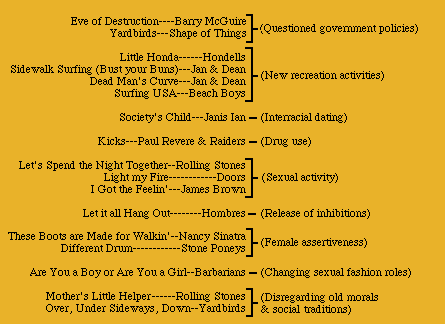 |
||||||
 |
||||||
 |
||||||
 |
||||||

"It's the Music They Want!"
| There had long been frustration in C'dale about the lack of quality radio service for students. This was more than the usual irritation we all have for schlock radio. There was almost no service at all. While we previously mentioned the monolithic and diverse aspects of top-40 radio in the 60's, that was macro. The micro is that the music penetrated deeply into all parts of the adolescent psyche. Especially for young adults, radio was a pillar of their lifestyle. More than just a music service, radio provided information (news, blurbs, promos about events, PSA's, commercials) and lifestyle reinforcement (values, attitudes, reactions to current events, fashion). All of these were synergized in the music. Here are some examples of hit songs from the mid ‘60s that impacted on these areas: |
||||||
 |
||||||
| All of these songs went top ten between 1965-67. During these years, an enormous proportion of the adolescent population listened to "Top-40" radio, mainly because that was the only type of format available that played music 12-23 year-olds considered "theirs." Stations featuring this format had 25%+ shares of their markets. The music was heard everywhere: Cars, beaches, dances, stores, garages, clock radios, transistor radios, even crystal radios. The music, and the top-40 format, was an integral part of adolescent life in the 60's. It was always expected to be present, and it was very conspicuous when it was absent. (There was also the growing presence of "underground" music, which, by the mid-70's, had gradually evolved into more mainstream "album rock" and eclipsed top-40 in popularity. But in '67, top-40 was still very much king). When students arrived in C'dale to begin their "higher education" they expected a concentrated and enhanced adolescent experience. They were severely disappointed that a key aspect was missing. Energetic students were unwilling to accept the status quo. The students were used to having their needs satisfied, and they were able and ready to take action to pursue this. They were unhappy that their radio needs were not being met. Mae Smith and Neely each had 500 rooms and 1000 residents, and they all had radios. In nearby University Park (Allen, Boomer, Wright) there were another 500 rooms and 1000 residents. In addition to a trailer park east of University Park, there were also off-campus residences (Wilson Hall, Quads, Garden Park). This meant that there were thousands of receivers, and thousands of listeners living within a few hundred yards of Schneider; thousands of potential listeners who were unserved and unhappy with existing radio offerings. At the same time, there were hundreds of students in C'dale who were there for the main purpose of learning about and practicing broadcasting. SIU had a nationally-prominent Radio-Television department for years, which established a reputation. Despite this, department-structured experience was severely limited for first- and second-year students. The first year R-T course, RT-161 (intro to announcing), was hard to get into due to high demand and limited space. The R-T department curriculum assumed students had no broadcast background, training, or skills before C'dale. Yet many students, especially those from Cook County, other urban areas, and veterans, arrived in C'dale with broadcast experience in high school, military, and even commercial radio and television. Some had had formal production, announcing, and broadcast history classes in high school. These students were frustrated when they discovered that R-T Department policies might force them to wait up to two years for equipment contact, instruction, and experience. They didn't want to wait. They were ready to explore a career in broadcasting, and they needed to hone their skills by practicing and working. They were looking for an outlet. As early as 1959, according to some reports, small "pirate" (illegal) stations operated on campus. Sometime in 1962, the "Residence Halls Council" (ie, Student Government-type body that represented dorm residents) surveyed students about media effectiveness, with a view to showing a need for an official student station. In that survey, there were 791 responses (out of an estimated 1200 dorm residents). 92.9% said they had a radio in their room, but only 18% had FM. Only 13% of respondents felt that WSIU-FM communicated "to the student body as a whole." |
||||||
end of Chapter 9
|
|||
|
|
|||
|
Message Board | The Source Contact |